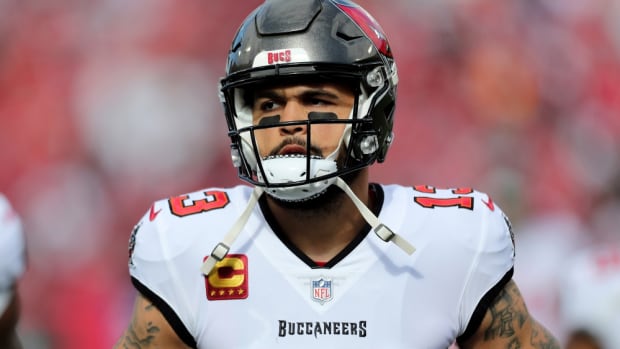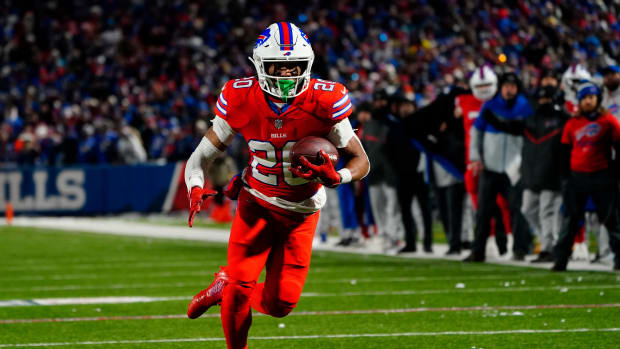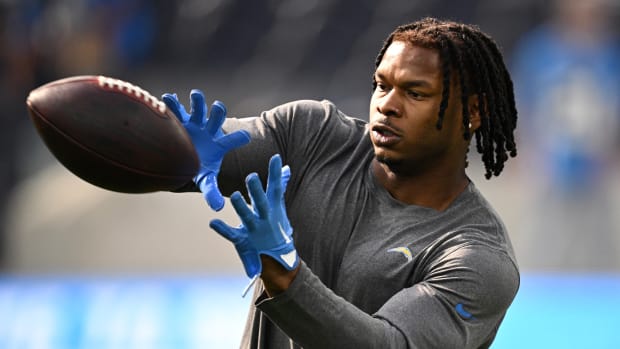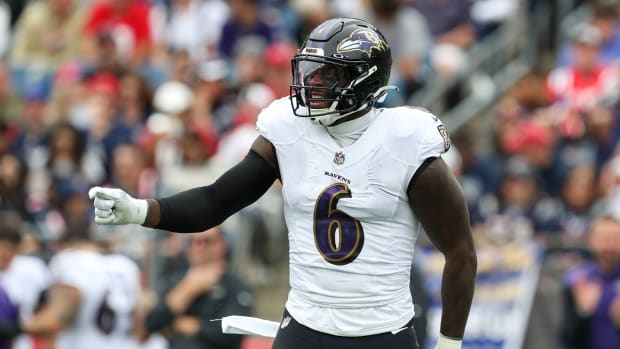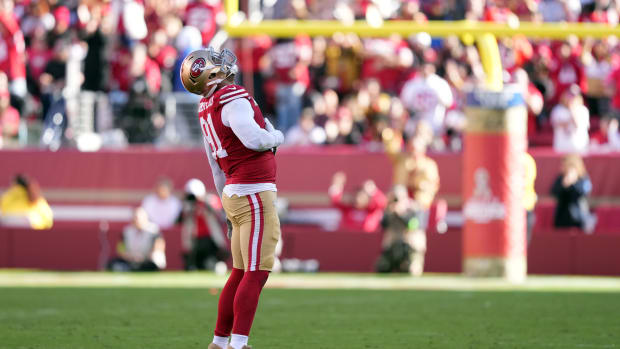
Pressure Points: Valuable Vike, but For How Long?
When the season is over, NFL teams will go scouring film and through statistics to find underrated pass rushers to target in free agency. Expect Vikings end Everson Griffen to be one of those players—if the Vikings let him hit the market.
His Week 14 performance against the Ravens was a perfect example of his subtle effectiveness. Despite not registering a sack, Griffen accumulated 4.75 Pressure Points with a drawn hold and eight quarterback hurries to earn both our Top and Unsung Edge Rusher of Week 14 honors. The total pressure generated allowed him to edge out several players who had multiple sacks, including John Abraham of the Cardinals, who had three (but just two other pressures).
"I think I had a pretty good game," Griffen said this week. "Went in there with great focus and ready to execute my assignment. I just feel like I had more opportunities on the edge rush to make my presence felt. I feel like I can play a lot better with the more opportunities I can get, but this game I was really focused and executing my assignment."
Griffen’s unsung and versatile nature has been on display all season. For his first three seasons, he had a natural progression as a fourth-round pick: 66 snaps as a rookie, four sacks in his second season and then eight sacks last year. This season, Griffen has just three sacks. But as we try to emphasize in this space, sacks are a poor measure of the ability to generate quarterback pressure.
Take this play, with 1:10 left in the third quarter against Baltimore, for example. The Vikings were trailing by one when Griffen, playing right end, bull-rushed Ravens left tackle Eugene Monroe back four yards. That caused Monroe to hold Griffen, and Flacco to vacate the pocket and throw an off-balance interception. Five plays later, the Vikings scored to take a short-lived lead.
"I just got off the ball and he overset me," Griffen said of Monroe. "I bull-rushed him, and I was going to snatch him by and he held me on the inside. I was trying to get off the block and the official made a good call. (Safety Andrew) Sendejo made a great break to get the pick."
Pressure Points: Valuable Vike, but For How Long?
griffen-1.jpg
griffen-2.jpg
griffen-3.jpg
griffen-4.jpg
griffen-5.jpg
Griffen said he was more effective in this game because he was allowed to play on the edge more. Sitting behind established starters in Robison and Allen, the 6-3, 273-pound Griffen has been asked to be more of a utility player. Most of his time has come as an interior pass rusher. Griffen has been fine in his role, but desires a chance to be an every-down end.
"I'm the guy that's able to do it all because of my versatility," Griffen said. "I stand up when we have our stroker package. I drop into coverage. I play nose tackle, I play tackle, both ends. So I play everything on the line and with a little bit of linebacker presence to it. I'm the do-it-all guy. It's been a fun ride doing it all, but I really want to be able in the upcoming years to perfect my craft at one position."
Will that be with the Vikings? The team has locked up Robison with a contract extension, but Allen will be a free agent.
"People said I want to test free agency—I never said that," Griffen said. "Wherever I end up, I just want to be able to perfect my craft at one position. I will play inside sometimes, but I'm an end and I want a chance to show people what I can do year in and year out and not be a guy that moves. I love doing what I do, moving around, but either I can stand up in the 3-4 at linebacker or I'm an end.
"Once a Viking, always a Viking. I would love to be a Minnesota Viking throughout my whole career. It's up to them. You have to let the chips fall where they may."
With his subtle production, Griffen is likely going to get that chance. The only question is where?
* * *
Interior rusher of Week 14
Gerald McCoy, Tampa Bay Buccaneers
After being held to just 1.5 Pressure Points last week against the Panthers (three hurries), McCoy resumed his dominating ways with 5 Pressure Points against the Bills: one assisted sack, one sack assist, one drawn hold, five hurries and one hit.
McCoy has now won this award three times in the past four weeks, including Weeks 11 and 12.
McCoy showed his ability to affect the quarterback even against a double team on a third-down sack ultimately recorded by Derek Landri. McCoy powered the Bills left guard right back into the feet of quarterback E.J. Manuel, who had to roll to the right—directly into the stunting Landri for a seven-yard loss.
Pressure Points: Valuable Vike, but For How Long?
mccoy-1.jpg
mccoy-2.jpg
mccoy-3.jpg
Unsung interior rusher of Week 14
J.J. Watt, Houston Texans
Another week, another chapter for the "his team might stink and his numbers don’t look that impressive, but J.J. Watt is still having a monster season" book. Watt was held sackless for the second straight week, but he still caused a sack, drew a holding penalty, hurried the quarterback four times and hit him another three.
Just before halftime, Watt kept fighting against the left tackle and guard to nearly sack Jaguars quarterback Chad Henne. Henne got away, but he ran right into Brooks Reed, who should be sending Watt a nice present for the gift-wrapped sack.
Pressure Points: Valuable Vike, but For How Long?
watt-1.jpg
watt-2.jpg
watt-3.jpg
watt-4.jpg
* * *
* * *
OUR METHODOLOGY
One of biggest indicators of success for NFL defensive coaches is the ability to affect the quarterback.
Sure, that means sacks, which are an official NFL statistic. And quarterback hits, which are also tallied in press boxes. But affecting the quarterback, making him feel pressure, has several other factors, most of which aren’t officially tallied (though NFL teams do them internally).
We at The MMQB thought long and hard about finding a better way to evaluate quarterback pressure, both from individual and team standpoints. We’ve developed our own formula, which we think will highlight players who aren’t getting the glory stats (sacks) but are still affecting the quarterback just as much.
The two statistics that we’ll be tabulating are sack assists and drawn holds. The latter is self-explanatory. Pass rushers are sometimes held by offensive lineman before they can sack the quarterback. Those plays aren’t official plays for the NFL. But they can be nearly as damaging. It’s a 10-yard foul, although there is no loss of down.
A sack assist is given to a player who allows a teammate to get a sack. You see it all the time. One player comes flying at a quarterback, causing him to bolt, and the QB winds up in the arms of a different defender. Sometimes the sacker didn’t do very much, yet he still gets credit for the sack. The player who actually caused the sack gets nothing. We’re going to change that.
Here’s how the formula works.
Sacks
Because not all sacks are created equally, we have divided up sacks into three categories: solo, assisted andeasy.
Solo sack (1.25 points): For the player who beats a blocker and gets the sack on his own. These are the real sack masters; they should be rewarded for their standout individual effort.
Assisted sack (.75 points): Given to the player who officially receives a sack but had help from a teammate in taking the quarterback down.
Easy sack (.75 points): An official sack that falls into one of the following categories: coverage sack (quarterback held the ball longer than 3.3 seconds because the coverage was so good); unblocked, usually because of a schemed blitz; offensive miscue, such as the quarterback tripping after getting stepped on by an offensive lineman; or garbage-time sack, which we have defined as a sack when the offense is trailing by more than two scores with four minutes or less remaining in the game.
Sack assist (.5 points): As described above, this is when a player aids in the sacking of a quarterback. The official sacker will get an “assisted” or “easy” sack (.75 points), and the disrupter gets a “sack assist.”
Disruptions
These three categories—drawn holds, hurries and hits—are not official statistics, but they’re extremely important. A team can have zero sacks, but if they accumulate hurries or hits, they’re making life extremely uncomfortable for a quarterback. The hurries and hits are shared with us by our friends at ProFootballFocus.com. Our hits and hurries include plays wiped out by penalty.
Drawn hold (.75 points): The player who draws a holding penalty on a pass play. Only tabulated if the penalty results in a “no play.” If there is holding on a sack and the sack counts, there is no drawn hold—although that player could get a sack assist.
Hurry (.5 points): When the actions of a defender causes the quarterback to alter his throw or footwork. This is what defenses call “moving a quarterback off his spot.”
Hit (.5 points): Recorded just after or as the quarterback releases a pass and goes to the ground as a result of contact with a defender.
Once the film is graded, we come up with Pressure Points. We feel this is a much better way to evaluate what kind of quarterback pressure a player or team is generating. We will divide the performances by edge rushers(ends and outside linebackers), interior rushers (tackles and inside linebackers) and by team. Individually, we will handout two awards for both edge rushers and interior rushers.




















































